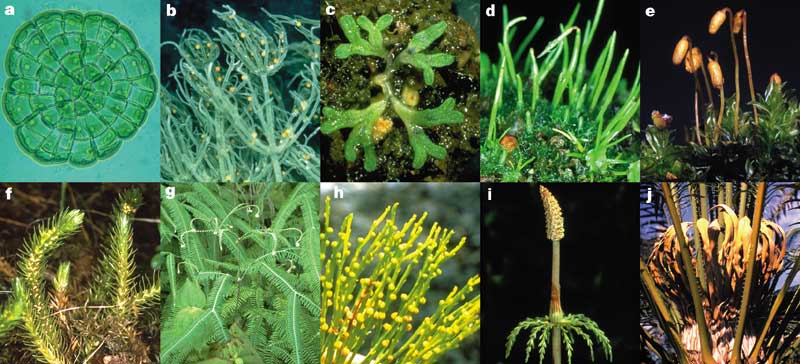
a color plate from the essay
The Origin and Early Evolution of Plants on Land
by Paul Kenrick and Peter R. Crane
Figure 1 (from page 218 of Shaking the Tree: Readings from Nature in the History of Life edited by Henry Gee)
Morphological diversity among basal living land plants and potential land-plant sister groups. a, Coleochaete orbicularis (Charophyceae) gametophyte; ×75 (photograph courtesy of L. E. Graham). b, Chara (Charophyceae) gametophyte; ×1.5 (photograph courtesy of M. Feist). c, Riccia (liverwort) gametophyte showing sporangia (black) embedded in the thallus; ×5 (photograph courtesy of A. N. Drinnan). d, Anthoceros (hornwort) gametophyte showing unbranched sporophytes; ×2.5 (photograph courtesy of A. N. Drinnan). e, Mnium (moss) gametophyte showing unbranched sporophytes with terminal sporangia (capsule); ×4.5 (photograph courtesy of W. Burger). f, Huperzia (clubmoss) sporophyte with leaves showing sessile yellow sporangia; ×0.8. g, Dicranopteris (fern) sporophyte showing leaves with circinate vernation; ×0.08. h, Psilotum (whisk fern) sporophyte with reduced leaves and spherical synangia (three fused sporangia); ×0.4. i, Equisetum (horsetail) sporophyte with whorled branches, reduced leaves and a terminal cone; ×0.4. j, Cycas (seed plant) sporophyte showing leaves and terminal cone with seeds; ×0.05 (photograph courtesy of W. Burger).
Back to the list of color illustrations.
About the book: Shaking the Tree: Readings from Nature in the History of Life edited by Henry Gee, published by the University of Chicago Press.